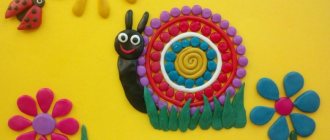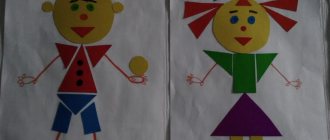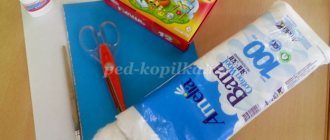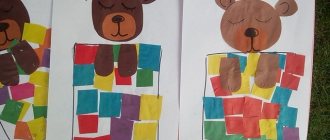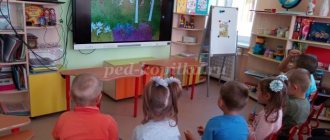How to make appliques from paper Wild animals. Print our free templates, color them however you like, cut them out and glue them together!
The proposed applications - a symbiosis of coloring books and cut-outs - will be useful for the development of the child. They will help improve coloring, cutting, designing , develop fine motor skills, precision of movements, spatial thinking, attentiveness, and perseverance.
See also:
- colored paper applications,
- learning to cut with scissors - the simplest templates.
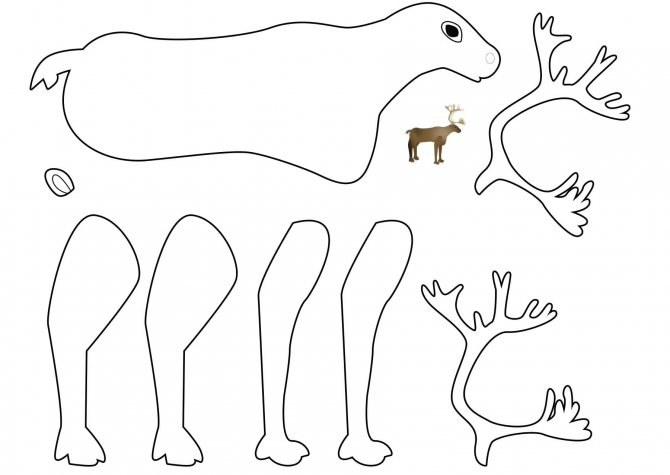
Print applique templates Animals
Applique Grizzly Bear
Grizzly Bear Facts
- Although grizzly bears are not endangered, an existential threat exists. 1,000 grizzly bears left in the wild .
- Grizzly bears are a North American subspecies of brown bear.
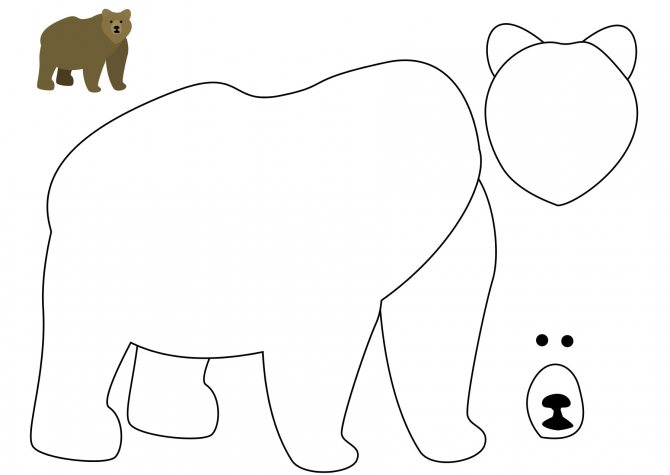
- Grizzly bears are often seen at some of Alaska's best fishing spots, where they feast to accumulate enough body fat to survive the winter.
- During the winter, grizzly bears hibernate. They dig holes on the hillside. Females give birth at this time.
- Grizzly bears are powerful predators, although they eat a wide variety of foods. Nuts, seeds, berries, fish, rodents and moose!
Schemes and order of execution of applications
"Cat"
– circle a template with a picture of a cat on a cardboard base;
– draw on the base the eyes, mouth, mustache, ears and paws of the animal;
– apply glue to the base with a brush, glue the cereal in accordance with the plan (the desired color and shape).
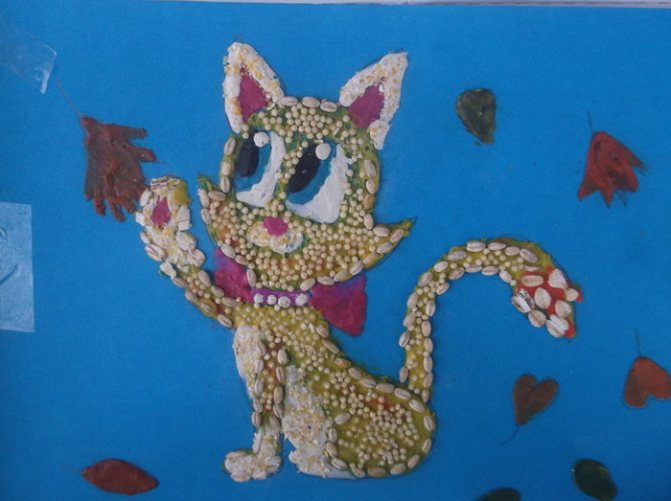
Cereal application
"Poodle"
– trace the template with the image of a poodle, cut along the contour (white paper);
– glue the cut out element onto the base, in accordance with the plan, glue cotton balls onto the image of the dog;
– complete the necessary details (muzzle, claws) with felt-tip pens.
Craft template

Cotton ball applique
"Calf"
– trace and cut out elements from felt of different colors according to the template;
– stick the parts onto the base by overlapping.
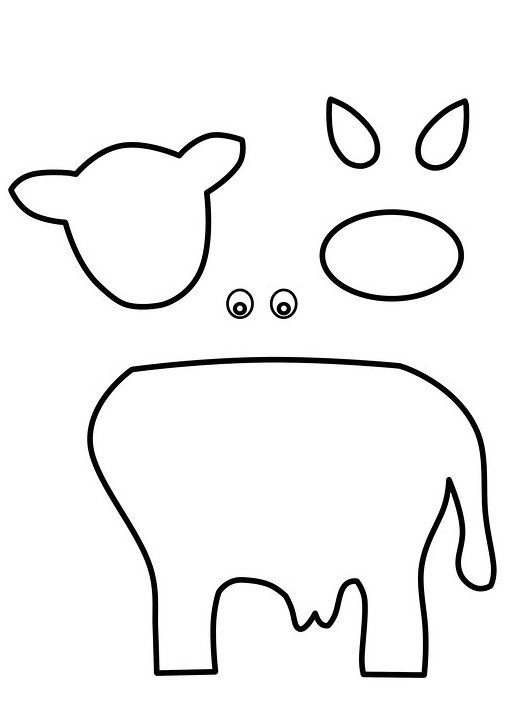
template for appliqué
"Puppy"
– draw and cut circles of different diameters from paper of various colors in accordance with the plan;
– glue the modules to the base, bending them according to plan.
Modular application scheme
"In the forest"
– paint the base for the workpiece;
– glue parts made of natural materials.
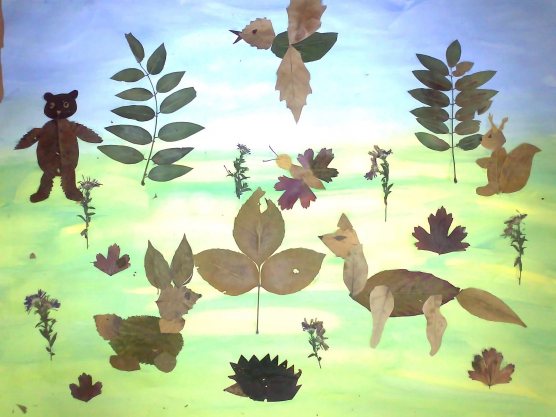
Group application
"Bears at the Pole"
– glue elements for creating a photo (crumpled paper, cotton wool) onto a colored base;
– draw and cut out an image of bears along the contour;
– glue new details to the background image;
– complete your plans with felt-tip pens.
Group application
"Elephant"
– glue the leaves onto the base in accordance with the plan (overlay and design technique).
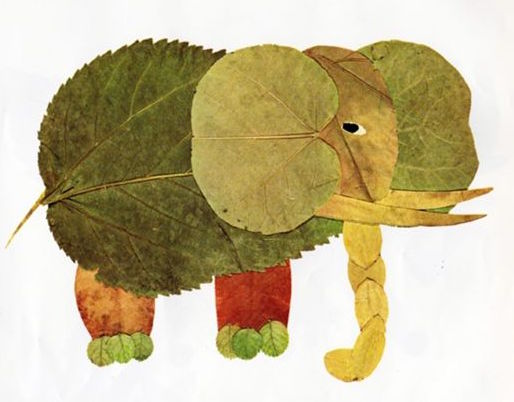
Application made from natural materials
"Lamb"
– create elements using the quilling technique (performed by a group);
– stick the elements onto the base.
Application using quilling technique
"Fish in the Aquarium"
– each student makes a fish using the origami technique;
– complements the part with simple elements (stripes, circles);
– gluing parts onto the base.
Application with origami elements
Paper applique Raccoon
Raccoon Facts:
- Raccoons will eat anything. Insects, mice, fish, eggs and even garbage!
- Because they eat almost anything, you can find raccoons in any environment - from the farm to the city!
- Raccoons love to live in hollows, logs, and even attics! Young raccoons often spend the first two months of their lives high in tree holes until their mother drops them to the ground.

- Raccoons typically live 2-3 years in the wild.
- Northern raccoons hibernate - they binge on food to store fat and then sleep in their den all winter.
Applications with sea animals
We have already talked about which animals of hot countries most appeal to children. Now let's talk a little about the mysterious sea inhabitants!
Photo MK
Dolphins are considered the most popular marine inhabitants. They attract people with their kindness and responsiveness. And it is their figures that we suggest you use for applique on a marine theme: Using stencils, dolphins can be formed from colored sheets, napkins or cereals:
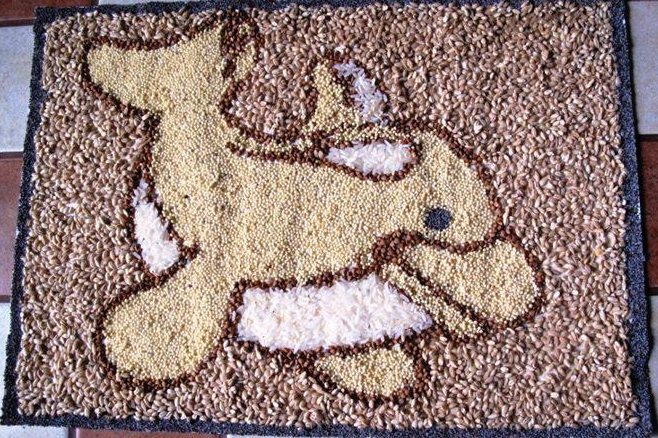
Video tutorial applique dolphin from plasticine
Lion clipping
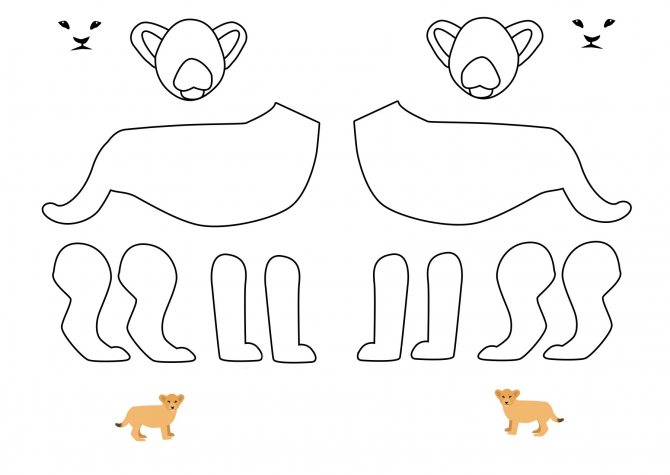
Facts about lions:
- Lions live in groups called "prides".
- Male lions boast a mane, a large fringe that encircles their heads.
- Males defend the pride territory, which they clearly mark with the smell of their urine.
- Lionesses are hunters in a pride. They often work together to hunt antelope, zebra, wildebeest, zebra, etc.
- Most lions on earth live in Africa, although a very small population can be found in India's Gir Forest.
Wombat paper applique
Wombat Facts:
- Wombats are marsupials, meaning they have pouches on their bellies in which they raise their babies.
- A baby wombat lives in its mother's pouch for about five months before it emerges.
- Wombats use their claws to dig burrows in eucalyptus forests and grasslands.
- Wombats are nocturnal and they are vegetarians (herbivores). They come out at night to eat grass, bark and roots.
- A wombat that burrows in fields can be a destroyer of ranches and crop-dependent farms.
Application “Domestic and wild animals”
Pupils were introduced to the topic “Domestic and wild animals” during classes on the surrounding world in the junior and middle groups. They know the classification of animals, to what extent certain ones depend on environmental conditions, and how they adapt to existence. They know the habitats of wild animals, some behavioral features, which animals are herbivores and which are predators. They can tell no less about domestic animals: those who live on a farm, and about pets in city apartments. Repetition and consolidation are most successful when calendar and thematic planning for the year is compiled in such a way that a return to the topic of animals occurs first in a lesson on cognitive and speech development. Pupils, together with the teacher, systematize previously acquired knowledge, develop oral speech skills, and develop an attitude towards an attentive attitude towards the surrounding world, including animals, towards a healthy lifestyle with the maximum harmony with nature in the modern world. And later, in planning, a creative activity is organized on the same topic: drawing, modeling, creating panels or appliqués.
If an individual form of work is chosen, then students can be asked to make several animals on one basis or complete several crafts per lesson if a simple appliqué technique is used. It is preferable for children of this age to use a group form. The teacher divides the children into groups of several people, and then the students independently distribute the actions necessary to create the application.
Preparing a teacher for a lesson
To make the lesson interesting and useful, you need to think in advance about the manner in which it will be held and what goals and objectives are desired to be achieved. First of all, it is necessary to select motivating material to lead the children to the topic and further immersion in the creative process. Options for the initial stage of the lesson :
- Conversation with students, answers to questions, stories from personal experience. Speech skills and thought processes develop, and memory is trained.
- Fairy tale. Perhaps the teacher will ask the students to remember tales about wild animals and try to retell one or two in a concise manner. To develop listening skills, the teacher tells a short story about animals. An example of a fairy tale about pets: “In the Village”: Once upon a time there were two friends Petya and Roma. Petya lived in the city, and Roma lived in the village. And Petya decided to go and visit Roma in the village. When Petya arrived, Roma decided to show him the farm. They went to a clearing and saw a cow there. -Who is this? - Petya was surprised. -This is a cow. It produces tasty and healthy milk. And from milk they make sour cream, cottage cheese and even delicious ice cream. And the cow also has very tasty meat. The boys went further and saw a horse. “Who is this?” Petya asks again. -This is a horse. It helps transport heavy loads and produces delicious milk called kumiss. After walking a little, the boys saw sheep nibbling the grass. “And these are sheep,” explained Roma. “They have very warm wool, from which they knit mittens and socks.” The boys came into the yard and saw the chickens. “What kind of birds are these?” asks Petya. - These are chickens. They lay eggs. And chicken soup is the most delicious and healthy soup in the world. Petya looked around and saw a dog. -And I know this. This is a dog. She guards the house. “That’s right,” said Roma. And the boys went home. Roma's mother fed Petya delicious chicken soup and gave him warm milk. Petya really liked it in the village. (Author: Nurtdinova Aisylu)
- Reading poems about animals. It is recommended to use musical accompaniment to complete the task of developing aesthetic taste and a sense of beauty (playing audio recordings in the background or using a projector to view a presentation with audio accompaniment).
- Use of visual material. Posters “On the farm”, “In the forest”, “At the zoo”, books about animals with illustrations, viewing slides or cards.
Photo gallery: examples of visual motivating materials
Poster Poster Poster

Poster Poster Set of magnetic cards (for blackboard)
Lesson notes
The outline should reflect the stages of the lesson, indicating the approximate time for each, the materials and tools used, what goals and objectives were set and whether they were achieved, and an analysis of the work done (what was successful and what was not) is required.
Note plan:
- Goals and objectives
- Tools and materials
- Step-by-step progress of work: organizational moment 3–4 minutes, discussion of the topic and order of actions 5 minutes, preparation of elements 14–15 minutes, gluing parts onto the base 4–5 minutes, demonstration of work, summing up 3–4 minutes
- Reflection
Example of a summary: applique from cotton pads
- Goal: making an application on a given topic. Objectives: improving fine motor skills, developing imagination and aesthetic taste, developing discipline and accuracy.
- Tools: scissors, glue with applicator, brushes and paints, felt-tip pens. Materials: cardboard or felt base, cotton pads.
- Organizational moment: the teacher welcomes the children, informs them about the purpose of the lesson, names the tools and materials. Discussion: students are invited to view a presentation on the topic “Domestic and wild animals” followed by answers to questions. The purpose of the conversation is to review the classification of animals. Next, he voices the task for applied activities: “Select one or several animals and independently create its image using the appliqué technique from the proposed materials.” Preparation of elements by students (painting disks in the desired color, cutting disks into smaller elements, folding disks to create a three-dimensional image). Gluing parts onto the base. Demonstration of works. Summing up: the teacher thanks the children for their interest in the topic and the work done, and especially praises the most successful crafts.
- Reflection: what difficulties arose during the lesson, what in the notes needs improvement, whether the goals and objectives were achieved.
Craft Panda

Panda facts:
- Pandas are an endangered species.
- They eat about 28 pounds of bamboo a day!
- Adult pandas weigh about 300 pounds (136 kg).
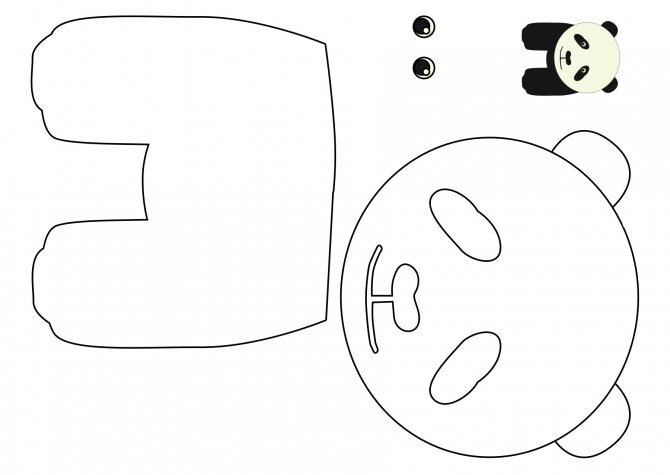
- Wild pandas live only in remote mountainous areas of China.
- Pandas are solitary animals.
Anteater applique
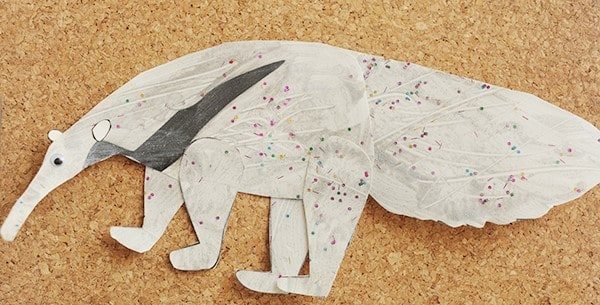
Anteater Facts:
- They are edentulous animals, meaning they have no teeth at all.
- Anteaters use their long tongues to swallow 35,000 ants and termites every day!
- They find food by smell.
- Anteaters live in tropical forests and grasslands of Central and South America.
- They live for about 14 years and are classified as endangered.
Craft Warthog
Facts about warthogs:
- The "spikes" and bumps on a warthog's face... those are warts!
- They are from the same family as the cute domestic pigs, although they look different.
- They have 4 tusks (although our template only shows two).
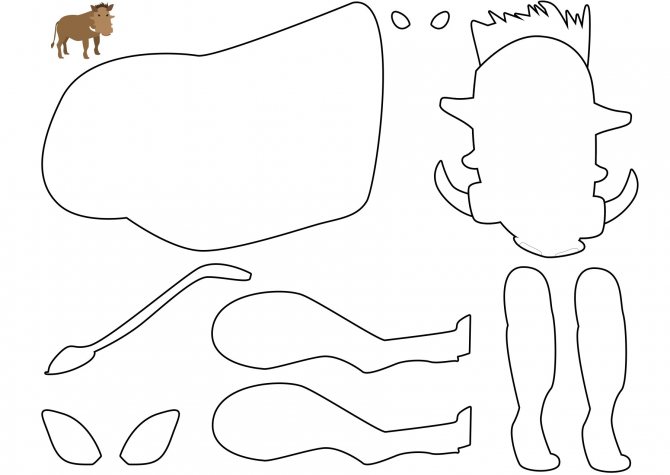
- They eat grass and plants and dig up roots and bulbs.
- They live for about 15 years.
- Warthogs can go for long periods without drinking water.
Classic type of application
First, children get acquainted with paper appliqué. It can be flat or voluminous. Small children glue animal details to cardboard. For example, you print out a template for coloring books, cut out the parts, and transfer them to colored paper. Animals can be designed using geometric shapes, which develops children's imagination.
It looks unusual. Animals made from paper balls and strips arouse great interest among children. For example, to make an elephant, outline an oval body on cardboard. Glue the leg strips. Take paper two centimeters larger than the body and cut it with a wide tail.
Knead, twist the tail, straighten the body, glue it. Also crumple and glue round ears, a head with a trunk. Decorate the top with grass (a piece of green paper cut into thin strips). If you are making an image with balls or stripes, then simply cover the template with multi-colored elements.
Baboon cutout
Facts about baboons:
- There are 5 different species of baboons and they all live in Africa or Arabia.
- Baboons are one of the largest monkeys in the world. Males weigh on average from 15-37 kg.
- Baboons prefer savanna and other semi-arid habitats.
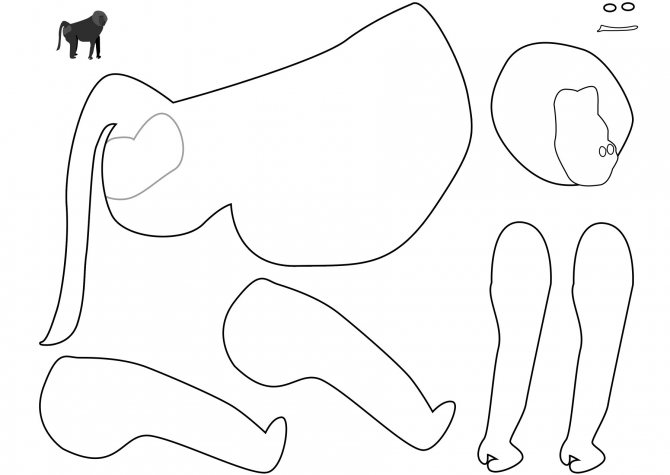
- They don't have prehensile tails like other monkeys, but they can climb trees to sleep, eat, or wait out trouble.
- Baboons eat fruits, herbs, seeds, bark, roots, meat and love to eat farm crops.
- They are known to form large orders of baboons, ranging from tens to hundreds with a complex hierarchical system.
- They can live about 30 years.
Lesson notes on the application “Zoo”
In the notes it is always d.b. etc. sod., not the goal. The words Educator are usually not written. And immediately there is direct speech - an address to the children, and in parentheses - the expected answers of the children.
Lesson notes on the application “Zoo”.
Purpose: Program content
— 1. Learn to display the characteristic features of animal images in an application. 2.Develop constructive abilities in drawing up a portrait (silhouette) of an animal from its parts. Strengthen the ability to cut out shapes from paper. Continue learning to cut out shapes along the contour. 3. Strengthen skills in working with scissors, glue, and a brush. 4. Develop accuracy, perseverance, and patience in children. To form an aesthetic attitude towards the work performed.
Material and equipment
Progress of the lesson.
Part 1 – introductory.
Educator: - Guys, Alf took a book from the book corner, and in it were riddles about animals. Alf can't solve a single riddle. Let's help Alpha? The children agree to help Alf.
Educator: -Alf, what riddles did you like, read them, and the guys will help you solve them.
Alf asks the children riddles:
It’s easy for us to recognize him, It’s easy to recognize him: He’s tall and sees far. (Giraffe)
In the zoo, Believe it or not, Lives a Wonder Beast. His hand is in his forehead. It looks so much like a pipe! (Elephant)
Children solve riddles.
Educator: - Alf, you see how easily and simply the guys can solve riddles.
Alf: Guys, where do elephants and giraffes live? Children's answers.
Alf: And on my planet, where I came from to visit you, there are no elephants or giraffes.
Educator: Guys, let's give Alpha a gift. We will make appliques of an elephant and a giraffe and give them to Alpha. The children agree.
Alf: I'm so glad, thank you guys.
Part 2 – the main one.
Educator: - Guys, what are we planning to do? Answer - (application of an elephant and a giraffe0. - What materials do we need for this? Answer - (colored paper). - What tools do we need? Answer - (glue, brush, scissors). - And how will we make an elephant, the sequence of actions I I’ll show you now (technical demonstration by the teacher).
Educator: -Guys, prepare your workplace. For those children who want to make an elephant for Alpha, take strips of gray paper, and for those children who want to make a giraffe, take strips of orange paper. (you can ask the children themselves about this)
Children independently cut out parts from strips of paper to applique the selected animal. Place the silhouette of an animal from the parts on the backing, spread and glue the parts. The teacher helps children only if the children have difficulties.
Part 3 is the final one.
Alf examines the children's work and thanks the children.
Alf: Guys, where can you see a giraffe and an elephant? Children's answers.
Alf: It’s good that I now know that you can go to the zoo and see animals that live not only in Russia, but also in other countries.
Educator: -Alf, sit on the chair, and I will read you a poem about the zoo, and the guys will show you a finger game.
Finger game "Zoo".
We are going to the zoo Material from the site www.logoped.ru
(index and middle fingers walk on the table)
,
Everyone is happy to be there (claps hands and knocks fists)
There are ponies, zebras, crocodiles, parrots and gorillas, there are giraffes and elephants, monkeys, tigers, lions. (bend fingers)
And in our hands we have a gun (show the gun with your hands),
It takes photographs
(pretend to be a camera),
Let’s take a photo for everyone (show with hands),
This is how you want to hunt
(clench and unclench your fingers).
game "Zoo". Educator: Guys, now try to portray the animals that live in the zoo.
Coordination of speech with movement: “Animals”
This is a lion. He is the king of beasts, there is no one stronger in the world. (we walk in a circle leisurely, raising our heads)
And funny monkeys shook all the vines. (spring, standing in a circle, feet shoulder-width apart)
But the smart, kind elephant sends his bow to everyone. (palms pressed to the head, body tilted forward - to the right, forward - to the left)
The leopard jumps so deftly, like our favorite ball. (jumping in place)
The pony runs, frolics, wants to make friends with us. (running in a circle with jumps)
The zebra shakes his head and invites him to visit. (hands on the belt, head tilted left and right)
Craft Leopard
Leopard Facts:
- Leopards are an endangered species.
- They are strong hunters and love to be in trees. In fact, they often drag their prey up trees to eat it!
- They are nocturnal.
- Leopards are very secretive and hunt antelope and deer under the cover of tall grass.
- They are also good swimmers and love to be in the water.
- Leopards are light colored with black spots called rosettes. There are also black leopards, commonly known as black panthers .
Fennec cutout
Fennec Fox Facts:
- The fennec fox is the smallest fox species in the world.
- They have huge bat-like ears that help radiate body heat and keep them cool in the desert.
- They mainly live in North Africa and the Sahara Desert.
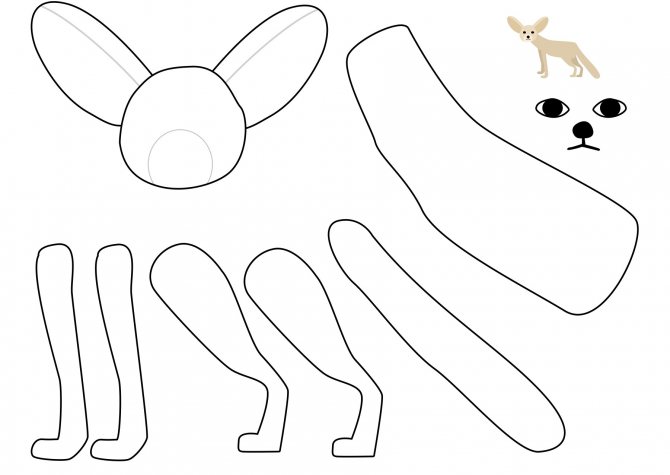
- They have long hair, which keeps them warm on cold nights and protects them from the hot sun.
- They live in underground dens in small communities of about ten foxes.
- Fennec foxes are omnivores and eat both plants and small rodents, eggs, reptiles and insects.
- They can go without water for a long time.
Howler monkey paper applique
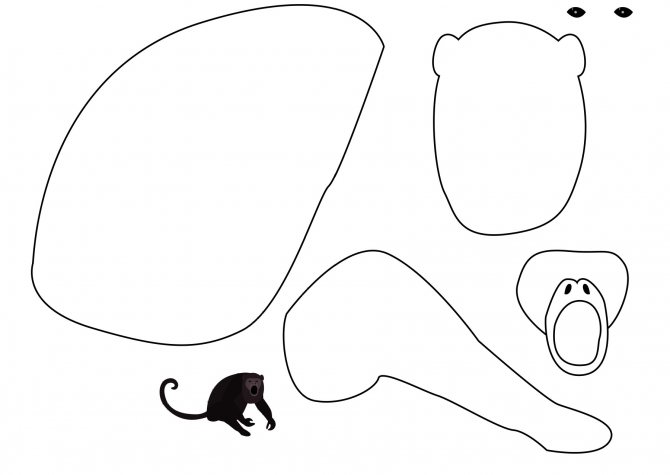
Howler Monkey Facts:
- Howler monkeys live in tropical areas of Central and South America.
- They howl so loudly that they can be heard up to 5 km away.
- They have what is called a "prehensile" tail, which means they can use it as an extra hand to grasp branches.
- Howler monkeys can live 15-20 years in the wild.
Skills and abilities of children of the senior group in application
What have children of the sixth year of life mastered in the field of appliqué? First, they know how to handle scissors safely. The health of the students is the priority of the kindergarten, and each teacher gives his students clear instructions on how to use scissors so as not to harm themselves and their friends.
In addition, children in the older group can:
- cut the paper into “straws” and wide strips of different lengths;
- tear the cut strips into pieces and place them on plates for later use;
- cut circles from squares and ovals from rectangles using smooth rounding of corners;
- cut geometric shapes, getting smaller or new ones (small rectangles from a large one, triangles from a square); cut out objects or parts of them from paper folded in half and accordion-style:
- use glue carefully and sparingly, remove excess glue with a napkin;
- coat part of the application with glue and fill this area with scraps of paper, cereal, cotton wool and other materials;
- combine in one work several types of materials, various techniques and methods of making parts (quilling, designing, modeling, drawing).
One or several children can work on the image of an animal, depending on the complexity. If a collage is planned, children can prepare animal figures in advance during independent visual arts activities, and during the lesson they can only cut and paste them.
Children in the older group know how to work without interfering with each other. consulting and interacting
Gorilla cutout
Gorilla Facts:
- Gorillas are classified as endangered.
- There are only 700 mountain gorillas left on Earth.
- Although their numbers are slowly increasing due to conservation efforts, habitat loss and poaching still pose a major threat to these animals.
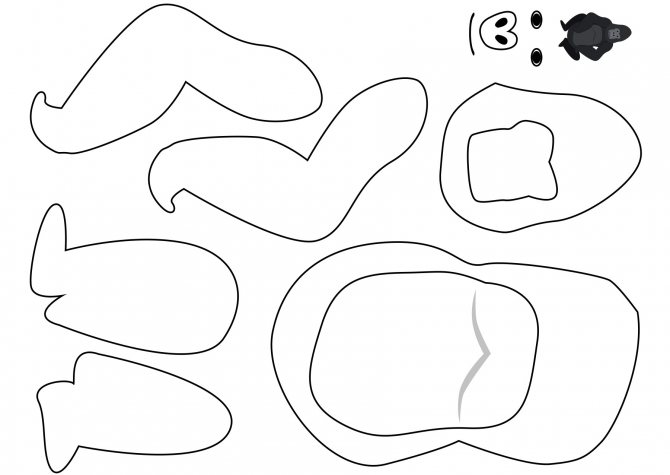
- Baby gorillas love to ride on their mother's back.
- Gorillas are herbivores and primarily eat bamboo and other leafy plants.
- Gorillas can live 40-50 years.
- They are very smart!
Non-standard application
Try different techniques with your child. For example, a felt elephant in a geometric style (round head, oval eyes, rectangular tail and trunk, square two-color ears, diamond-shaped legs, trapezoidal two-color body).
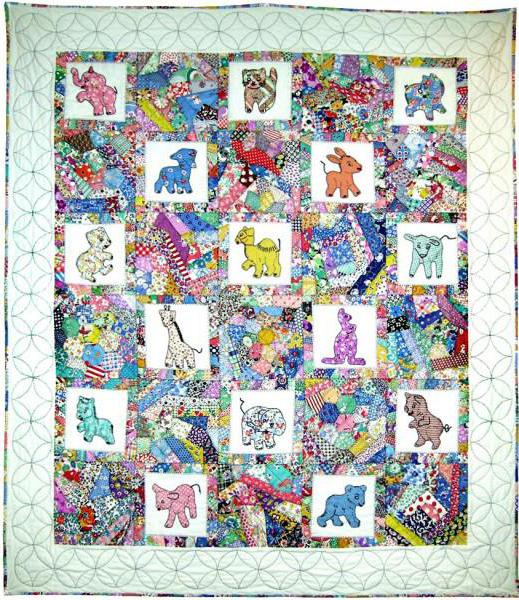
Or draw the image of a duckling on cardboard. Glue the eye, beak, and paws from seeds, and cover the head and body with millet. You can also make polar bears from dough, hares from semolina, hedgehogs from buckwheat or sunflower seeds. Even kids are attracted to the “cereal” applique “Animals”.

